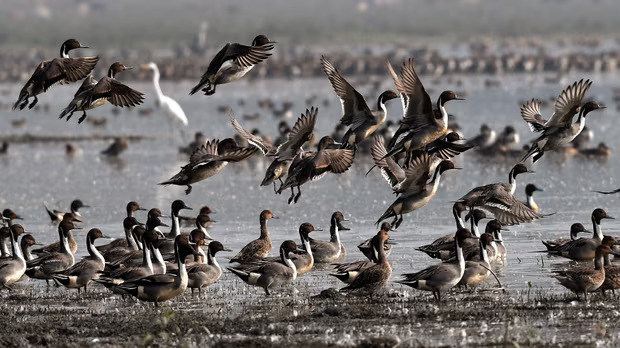The State of India’s Birds (SoIB) report, a recent revelation, has shed light on troubling realities within the nation’s bird population, painting a concerning portrait for numerous avian species.
Released just last week, this comprehensive report highlighted a distressing situation: 178 wild bird species in critical need of immediate conservation measures. Drawing insights from Indian birdwatchers and conservation organizations, the report meticulously examined the status of 942 bird species, even challenging assumptions about the presumed abundance of some common birds.
Notably, the report urged a reevaluation of 14 species, including the Indian roller, previously deemed of “least concern” by the International Union for Conservation of Nature (IUCN).
Ding Li Yong, Asia advocacy and policy manager for BirdLife International, stressed the report’s significance in providing a continental-scale perspective, noting, “The SoIB report offers an expansive view of species status, guiding crucial conservation strategies.”
India’s avifauna comprises an astounding diversity of around 1,350 bird species.
A collaboration involving 13 conservation and research organizations meticulously evaluated the conservation priority of the 942 species, categorizing them as high, moderate, or low. This analysis drew from a wealth of over 30 million field observations contributed by a dedicated community of nearly 30,000 birdwatchers leveraging the online platform eBird.
The report’s revelations were stark: nearly 60% of the 348 species studied over 25 years showcased concerning long-term declines. Additionally, 40% of the 359 species assessed since 2015 suffered troubling declines.
The report underscored significant drops in raptor and duck populations, alongside unexpected declines in seemingly common species like the great grey shrike.
Migratory birds bore a heavier brunt compared to non-migratory counterparts. Classified by their diet, carnivorous, insectivorous, and grain-eating birds faced sharper declines than fruit- and nectar-eating species.
Moreover, birds inhabiting specific habitats, such as grasslands and shrublands often categorized as wastelands in India, witnessed swifter declines than those in more open habitats.

The State of India’s Birds (SoIB) report peels back the layers of declining bird populations, revealing a tapestry woven with enigmatic reasons for the dwindling numbers.
Within its 2023 edition, the report not only flags the urgency surrounding conservation for 178 species but delves into a multifaceted puzzle of potential threats. From the shifting landscapes due to urban sprawl to the quiet degradation of vital ecosystems and the encroachment of singular farming practices, the report paints a grim picture. It unearths concerns about infrastructure development, pollution, and the ominous specter of climate change looming over avian habitats.
Despite this thorough exploration, the report’s publishers lament the obscure understanding of the precise triggers behind these declines, urging further investigation into these intricate causes.
Beyond statistics, this iteration pinpoints four priority species in each of India’s 36 states and union territories that urgently need conservation attention. Moderate conservation priority species signal early warnings, while those classified with low conservation priority mustn’t slip from the radar.
In the face of these challenges, Suhel Quader from the Nature Conservation Foundation underscores the importance of preserving commonplace species, asserting, “Safeguarding common species is pivotal.”
Amid the discouraging trends, the report unveils a silver lining, identifying 217 species showing stable or rising numbers. However, the surge of feral rock pigeons, Asian koels, and Indian peafowls, while thriving, raises questions about their impact on more vulnerable counterparts.
Interestingly, amidst the flux, steadfast birds like the Baya weaver and pied bushchat maintain a reassuringly constant presence.
Highlighting the need for public engagement, the report’s publishers draw attention to the uncharted territory of rare and nocturnal bird species, urging expanded research and data collection methods beyond conventional birdwatching scopes.
